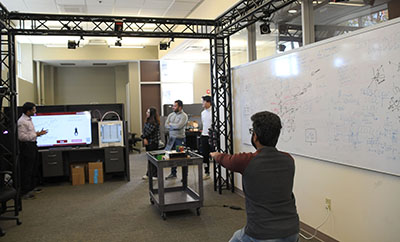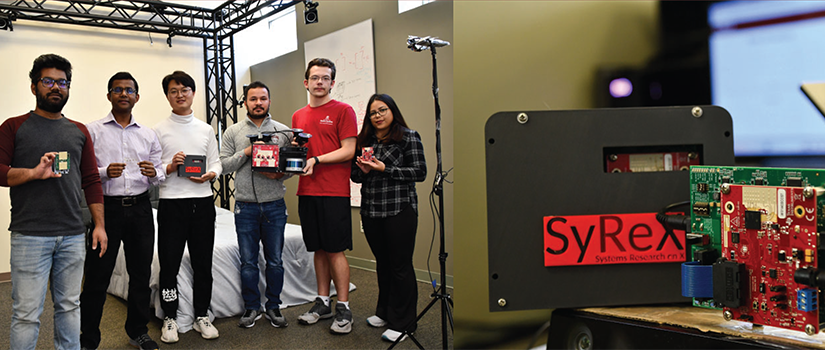Imagine driving at night in heavy fog without having to worry about not seeing the car or a pedestrian in front of you. Or a physician monitoring a patient’s rehabilitation without any visits to the doctor’s office.
Computer Science and Engineering Assistant Professor Sanjib Sur’s research team is working toward designing and implementing innovative systems and technologies with advanced wireless and mobile infrastructure to help improve individuals’ health, safety and convenience.
Sur’s research group is known as Systems Research on X (SyReX). The “X” represents the group’s current focus on wireless networking, mobile computing and applied artificial intelligence/machine learning. His work is based on two critical foundations. Next-generation wireless network architectures aim to serve devices with reliability and resiliency, while ubiquitous sensing techniques enable devices and objects to be truly smart by understanding and interpreting environments and conditions with high precision.
“In our lab, we not only have smart devices, but smart systems embedded inside different environments,” Sur says. “Our idea is to reconfigure already existing devices such as wireless routers to design and implement advanced wireless sensing technologies and bring them to the masses.”
Sur’s current projects with next generation wireless networks go beyond the current 5G network and involve the merging of high-speed data connectivity with sensing for healthcare and automotive applications. The vision of Sur’s group is for their research to influence and be integrated with the 6G network and standards that are expected to be implemented by the year 2030. “One of the reasons I wanted to call it the NextG Wireless Research Center is that our research will be for 6G and beyond.”
A current project involves placing wireless devices on top of drones for flying over a hotspot area to provide more bandwidth where congestion could cause cell connections to fail. The drone then creates dynamic network activities to release some of the congestion and flies back to its base for recharging. The wireless devices mounted on the drone can also monitor and navigate in darkness or low light by interpreting the environment and identifying obstacles to navigate around them, which can potentially aid in future search and rescue missions.
Another current project is a virtual reality (VR) application that requires a large bandwidth data connectivity between the sender and receiver.
“If there’s an obstacle in between the VR device and wireless router, the connection will be lost because the high frequency signals do not penetrate through a human body or a wall very well,” Sur says. “Instead, by placing smart stickers on a wall, the signal can be steered towards the wall and bounce off it to reach to the other end if the line of sight is obstructed.”
Sur’s other research area is ubiquitous sensing. This uses millimeter-wave wireless, the core technology of 5G and beyond standards for sensing human activity and through-obstruction imaging. Projects include contactless monitoring of human sleep, activity, gait and vitals, and developing a device for autonomous cars to see pedestrians, cars, and obstructions in zero camera or Light Detection and Ranging visibility.

“For example, using one of our prototype systems in the lab, we were able to classify in real-time the different types of human activity with wireless signals,” Sur says. “But we can go beyond that by getting someone's body structure using wireless signals and AI model without a camera or a device on the body. We’ve found that there’s a good match between the body structures estimated by the camera and our wireless system.”
Ubiquitous sensing research is more than determining simple activities. It can also identify the position of limbs and legs for improving healthcare treatment. For example, an elderly individual who suffered a stroke could be told to rehab at home by a doctor by doing specific exercises such as lunging or frequent walking.
“How do you enforce this treatment, and can we bring a virtual doctor into someone’s home by designing an intelligent system? Since installing a camera at home is privacy invasive, our idea is to use a home’s wireless router embedded with sophisticated signal processing and AI models to monitor and figure out if someone is not properly doing an activity,” Sur says. “In that case, the real doctor can give feedback that will make the system more effective. It's not just monitoring but ensuring that the activity is done correctly.”
Aakriti Adhikari is one of Sur’s graduate students whose research focuses on integrating machine learning with mmWave technology in 5G devices to create home-based wireless healthcare solutions.
"Working with Dr. Sur since fall 2020 has profoundly enhanced my problem-solving skills and critical thinking, equipping me with a unique approach to research and a solid foundation for future challenges,” Adhikari says. Under his guidance, I've learned not only to analyze problems critically but also to approach them with a creative mindset.”
Sur is most excited about having a center to explore devices and innovative technologies instead of working on a product in research and development in a corporate environment. He has also supervised several undergraduate and graduate students, many of whom have been awarded best poster awards, NSF graduate research fellowships, Institute of Electrical and Electronics Engineers Microwave Theory and Technology Society scholarships, Association for Computing Machinery Grace Hopper Celebration awards, Computing Research Association Outstanding Researcher awards, University of South Carolina Magellan Scholar awards, and more.
“It's an exploration of what's possible and how to push the limit of certain technology without the fear of failure,” Sur says.
Within the next five years, Sur aims to eventually push his group’s current ideas and technology beyond a lab setting with cross-disciplinary collaborations. For example, his research group plans to work with a neonatologist at Prisma Health and researchers at the USC College of Nursing to place one of their wireless sensors outside the incubators of premature babies to monitor their vital signs in a contactless manner. This could potentially replace the standard process of placing sensors on babies, which can peel off skin and cause fatal infections.
“During the last five years at USC, I have built tremendous momentum and sustained a viable research program with competitive external funding,” Sur says. “I look forward to growing my research program and identifying and pursuing more opportunities for cross-disciplinary collaborations.”
